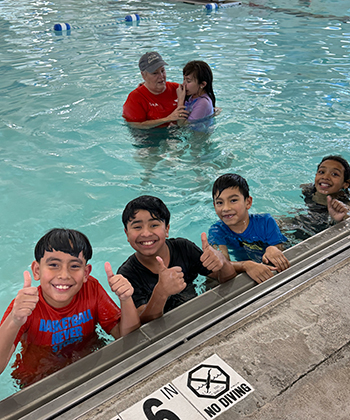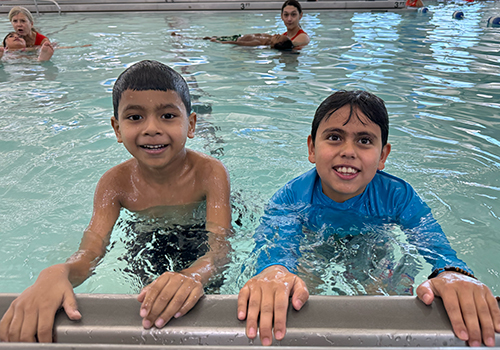By Kurt Rietema
A greater portion of January was spent bundling up and covering every exposed appendage from the extremes of the polar vortex. But on Wednesday afternoons, the kids in Youthfront Neighborhood’s Adventure Academy afterschool program in Argentine donned swimming suits as they splashed around the pool during swimming lessons at the YMCA. Peals of laughter and delight ricocheted across the surface of the water from every corner. A handful of the kids demonstrated a comfortable ease twisting and turning about on the surface like river otters. A greater portion of the kids sported big smiles, but simultaneously maintained a clawed, death grip on the pool lip. And finally, a few of the kids approached the water in full-fledged panic, convinced that this day would be their last.

But that’s why we do this stuff, right? A million gallons of crystal-clear water is an aquatic playground for those who through repeated exposure grow from floaties in the shallow end to ill-conceived cannonballs off the diving board. That same water can be menacing–not merely a psychological danger but a physical one–if you haven’t had the opportunity to habituate and develop skills that make it fun and keep you safe. Growing up in more economically-stable communities, it’s easy to take for granted skills and habits that are normal to almost everyone around us. But for kids in our neighborhood, opportunities to swim are more scarce. Many have parents who are equally unconfident in the water, swimming facilities are few, and opportunities for formal lessons are among the lowest in the entire region.
This isn’t the first time that the issue of unequal access to swimming has come to surface through our ministry with youth in our neighborhood. Three years ago, the young people in ImagineX, our youth social entrepreneurship program that leverages faith to help youth create solutions to the problems they care most about, conceived of a venture they called City Splash. They were frustrated by the fact that in a city of 150,000 people there was only one public swimming pool and that it was more than 8 miles away and more than 60 years old. Their idea was to borrow a page from well-established portable pool programs in LA and San Diego that bring pools to underserved neighborhoods for 3 weeks at a time for swimming lessons and limited-time-only fun and then take them to other neighborhoods. After a global pandemic buried their momentum with the local parks and rec department, this summer, a new cohort of young people picked up where they left off. Their public pitch opened the door for an invitation to share their idea with a group of C-suite executives later that summer which, providentially included in their audience, the director of the YMCA in Kansas City, Kansas. He was captivated. He’d never heard of any program like it until this ragtag group of middle schoolers brought it before him.

Fast forward to a recent Wednesday afternoon, Amber Booth, YF Neighborhood’s director for the Adventure Academy, was on the pool deck watching her kids practice back floats. The YMCA swim director was there as well, overseeing her team of swim instructors. Then she turned to Amber and said, “You know the reason that we offered swim lessons for these kids was because of the presentation that your middle schoolers gave to our director.” The kids in Adventure Academy were direct beneficiaries of the dreams that our middle schoolers had about a city where no kid was left out!
Later that night I told our son Luke, who was a part of the City Splash group who presented to the YMCA. A huge smile came across his face accompanied by an understated, Napoleon Dynamite-style fist pump. No, it wasn’t exactly what they’d set out to do. Swimming lessons for elementary-aged school kids isn’t the same thing as a traveling pool. And they personally didn’t receive the benefit they were hoping for. At least not yet. But he knew that he and his middle school friends drastically turned up the dial, moving the needle on a problem that has plagued our city that no one had an answer for.
The book of Ezra opens with an answer to a problem that had been an open wound for as long as the people of Judah had been living in exile. The temple was in ruins but the king of Persia was moved to rebuild what the Babylonian king had destroyed. It came as very good news and many who were carried off into exile returned to settle the land. The people organized to give money to the masons and carpenters, and gave food and drink and olive oil to the people of Sidon and Tyre so that they would bring cedar logs to rebuild the temple, and the articles of gold and silver that had been plundered from the temple were returned.
Ezra describes the excitement in the atmosphere. “And all the people gave a great shout of praise to the Lord, because the foundation of the house of the Lord was laid. But many of the older priests and Levites and family heads, who had seen the former temple, wept aloud when they saw the foundation of this temple being laid, while many others shouted for joy. No one could distinguish the sound of the shouts of joy from the sound of weeping, because the people made so much noise.” That last part gets me. There was reason for great celebration. Judah was on the brink of finally seeing change for a problem they’d waited a generation to see, But there was an asterisk to their joy. The ones who had known the temple in its full glory knew that this version would only ever be a shadow of its former self. They would likely never receive in full the dream they had most longed for, yet that day the entire nation felt the joy of a broken world being put back together.
One of the most influential writers of the Civil Rights movement, James Baldwin, related the impatient longing that Black Americans had for a better future to that of immigrants arriving on our shores. Immigrants left their home countries because they refused to become reconciled to the ruin of their children’s lives. Likewise, Black Americans, Baldwin insisted, only wanted what my own ancestors did. “They wanted to live, and not tomorrow, but today.” That phrase seems to capture the joyous ache that the older priests and family heads felt when they saw the foundation being laid. It expresses the yearning of every dreamer and every changemaker who longs to see the change they hope for in their own time. Baldwin’s words articulate what our middle schoolers feel when their creativity, energy and imagination bring about incredible feats of change that they celebrate and at the same time, the “not quite” nature of the results still leave them longing for more.
This is what I love about our ministry with young people in Argentine. Together, we’re learning what it means to be a resurrection people. We’re learning what it means to pray for God’s kingdom to come on this earth as it is in heaven. We’re learning to exchange despair for hope and translate desire into doing. We imagine and act towards those dreams, knowing that we may only ever see fleeting glimpses of God’s shimmering life break through in moments like those Wednesday afternoons when kids scream with delight, splashing around in pools made accessible by our cooperation with God’s Spirit to bring life out of places marked by death and decay.
About Kurt Rietema: Kurt is the Senior Director of YF Neighborhood at Youthfront. He holds a Master’s in Global Development and Social Justice from St. John’s University. Kurt is also an adjunct at MidAmerica Nazarene University and at William Jewell College. Kurt and his wife Emily live with their sons, Luke, Perkins and Leo in an under-resourced neighborhood of Kansas City, Kansas called Argentine.



